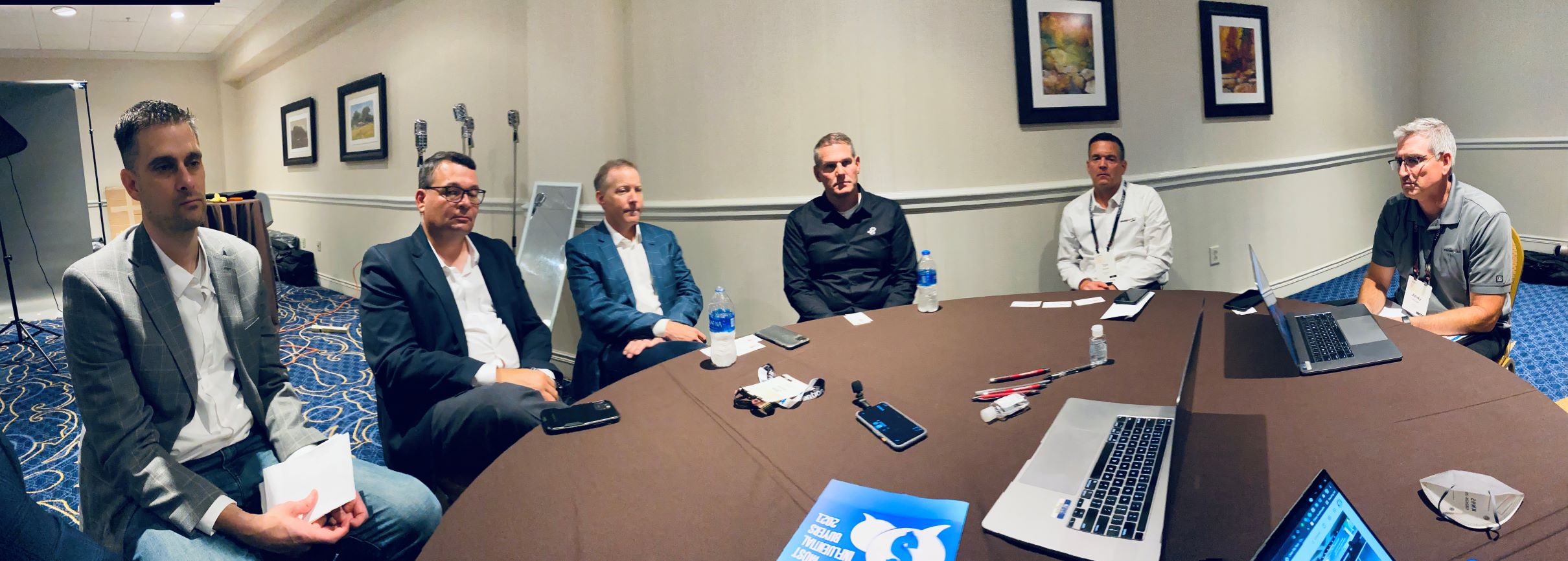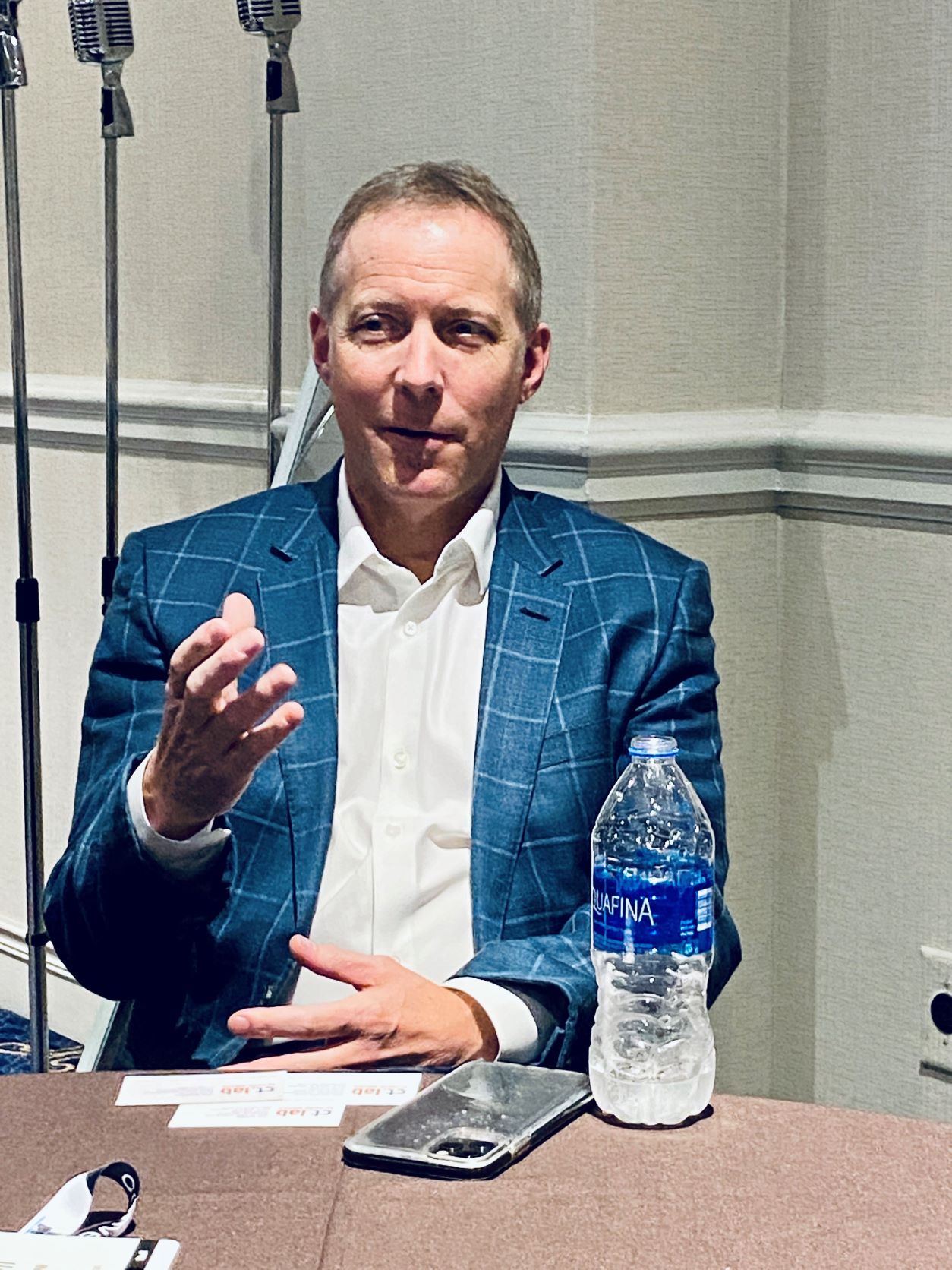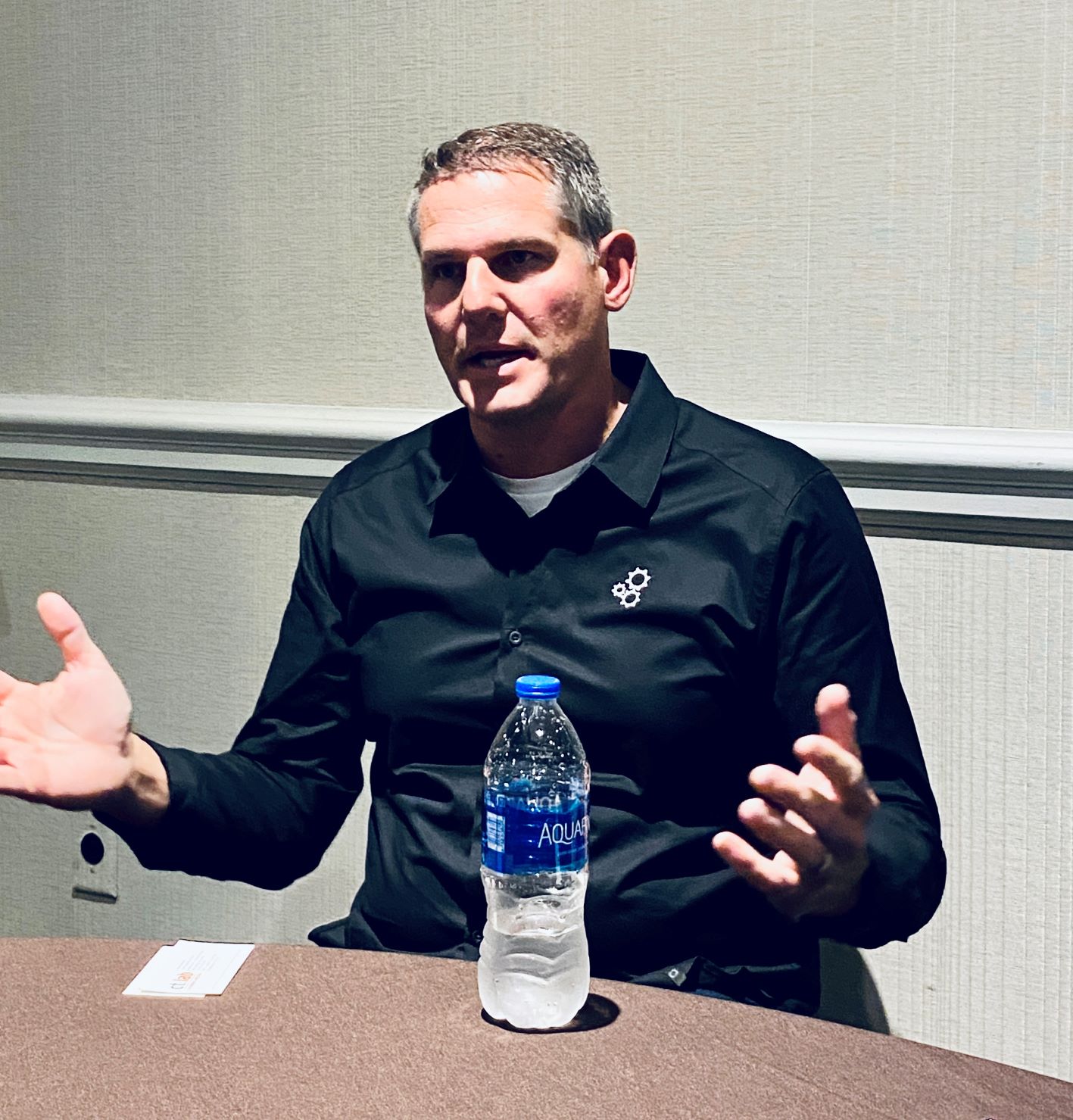
While in Nashville at the BrandSource 2021 Convention, we sat down, in person, with the buying group’s CEO Jim Ristow, CMO John White, COO Dave Meekings, and President Tom Bennett. Earlier in the conference, members of this senior management team had unveiled HR Source, a new initiative to help members recruit, hire, and retain employees, and The Hub, a new user-friendly integrated commerce platform aimed at simplifying and unifying the various elements of omnichannel retail scenario.
Your last in-person event was in March 2020. What were the main topics discussed then compared to this week’s conference?
Jim Ristow (JR): It was kind of unique in that we’ve been on a mission for almost four years now to bring our members to the forefront as far as digital marketing, website, and eCommerce is concerned. And our message at that event was: This is the way the market is going to be in the future. But our future was probably three to four years out. And we had been pushing them and pulling them and trying to get them there. In March 2020, the day we closed the show floor was the day that the country shut down, just as we were flying home, so thank goodness we had gotten so many to that place already, and others had just heard the message, because a few weeks after that stores were closed. Of course, you never want anything like COVID to happen, but the timing of the messaging was fortuitous.
Did the work-from-home element of your organization coupled with the revolution in retailing accelerate the development process of your new digital tools like The Hub?
John White (JW): It’s easy to be open to it, but we didn’t really have a choice. If you go back to April of 2020 and your store’s closed; if you were going to do business, you had to do it online, so there were a lot of things that happened really quickly, whether you wanted it to or not. And sometimes when you don’t have a choice, it’s easier to adopt it and I think our members learned a lot from that experience. In terms of tools in general, we generally take the approach that we’re going to do whatever it is for our members. We just need their buy-in and acceptance and their help with whatever it is.
JR: COVID was the great accelerator; it took a three-to-four-year cycle, and within weeks, it became today. We had to do it. And so two things happened: We reprioritized our roadmaps inside the technology company in a matter of days – literally — so that things that were going to be way out were going to need to be done sooner because the members needed them right away. These guys got it done, I don’t even know-how. And so also in reconfiguring what was important, it allowed what was to have been a four-year project into a two-year project that they’ve been able to implement now.

JW: A lot of the reprioritization of the things that were on the roadmap were more focused on how you communicate with your customers differently, because that was the expectation, and the only way to do it was with more credit card processing options and anything that was focused on actual selling out that day. The things that fell by the wayside might have been backend stuff, systematic improvements, or the way a dealer or retailer might interact with their system versus the way a consumer would. Anything that would help physically drive business went right to the front of the line and that’s what we worked on.
Plus you had your users providing needs and feedback in real-time
JR: Our unique claim to fame is summed up in a phrase we use: built by members, for members. We don’t do this in a vacuum; we actually have members that are part of the process from day one of whiteboarding to mid-build to go-live phases. So that also gives us two unique things: It lessens the need to pivot or make changes, though that’s necessary anyway, no matter what, but this greatly decreases that. The second thing is that we are so focused and narrow on what we’re able to produce that it’s almost at the pin.
You announced HR Source yesterday. Are the members jazzed about it?
Dave Meekings (DM): Yeah, I think they’re excited about it, especially since it’s typically something that doesn’t get a lot of forefront attention. The reactions have been good from a recruiting perspective, a hiring perspective, and a handbook perspective. Just having the security of the handbook—our members are very engaged with it, more than we even thought. We knew it was something they needed, but now they realize that they need it right now, and they’re reacting very positively.
JR: The different profiles and sizes of dealers that were interested in HR Source were a surprise. We thought this might be for our more mainstream types of members, but even our most progressive and largest members were interested. That part actually exceeded my expectation.
It was refreshing to see HR—employees—at the center of your announcements. What prompted the focus on HR?
JR: In a normal company, the shareholders are who you report to. You have to give value to them, you have to meet their market needs. We’re set up as a co-op. Our members–the dealers–we have to solve their problems. So we literally meet monthly with a roadmap of problems, and then resolutions. and we map this stuff out so as this is built to be a larger and larger dilemma for the members, we started working on this months ago, and we’re able to roll it out for the show,
Tom Bennett: During the pandemic, we started reading checking calls and we were doing them every other week with Chad and a bunch of the members of the team. We did them over Zoom so that the members, by region, could call in and, for lack of a better term, vent and talk about what’s going on. And these HR topics kept being brought up again and again, like we’re having hard with rules and safety and guidelines and workbooks and now I can’t hire people, how do I hire people and how are you finding people? We didn’t come up with the idea; we listened to our members, kept taking notes, and realized that this thing wasn’t going away. This is a real problem that we’re going to have to solve and invest some assets into it to try and fix it.

The other obvious issue that retailers in every sector are having is inventory. How is BrandSource addressing this issue for its members?
JR: If you remember from our keynote, we try to focus on two things for our members: information and MarTech. Since the pandemic hit, we’ve focused like a laser on giving our members the right information, and we didn’t do it in just one format. Tom just gave an example of one, but we go everywhere: We have YourSource news in an online format that’s live, we have newsletters that go out, we have fax blasts that go out that are just as specific as the online news and vendor blasts. And then we have the two-way formats that Tom was talking about. Besides facilitating member-to-member Zoom calls, we put a team in place to make one-on-one calls with our members to see if there was anything that was needed.
DM: We had about 15,000 conversations with members. Then on top of that, we are now focusing on certain areas, so we’ll have groups of members get together just to tackle service issues, or just on the furniture channel. And what we’ve launched here is getting people to sign up for the HR and staffing issues. We’re building these communities within the BrandSource community, which really allows our members to help their businesses on things like HR, which they don’t really have a lot of time to manage. We give them the tools to be as competitive as anyone else, and help scale that up for them.
In terms of marketing and advertising, which channels are growing the most?
JW: I’d say the biggest growth is probably social. Facebook advertising is still growing like crazy, then I would say next is probably OTT (over-the-top), so, advertising on streaming TV and on any number of platforms such as Hulu. Conversion rates on OTT are significantly different. More than half the population doesn’t have cable anymore and is on OTT. Unlike with traditional broad match TV advertising, where you run the ad to everyone that lives in the town, with OTT, you can target intenders, so only people who have looked at something in your category. So from a cost perspective, it’s super-efficient. folds different than what you would see between the number of cord-cutters exceeding, more than half the population doesn’t have cable anymore. And just the fact that Ott, you can target intenders. where think of normally when you’re doing TV advertising, you’re running the ad to everybody that lives in the town right well if you look at OTT you’re only targeting people that have looked at something in your category so you can truly target versus broad match TV. And it’s also not skippable, but you can click through on it. So, from a cost perspective, it’s super-efficient, comparatively speaking.
What about data and privacy around not only targeted advertising, but also transactions?

JW: If we were pre-pandemic I would have said that our members needed to hurry on being up to date with data and privacy protocols because it was coming faster, but then you throw governments in and a lot of other things that are priorities right now and it’s slowed down in terms of how fast privacy was coming. In general, though, even though that stuff has slowed down, I think it’s still important for dealers to think about it. And not just privacy, but also the security in their systems given all of the hacking that’s going on. Most of the privacy stuff, we handle for them. If you physically purchase from a retailer, you have no assumption of privacy, right, because you have to give your name to get the delivery and all those things are normal. It’s the web stuff, where you’re collecting and where you’re sharing that data across to other parties people that’s unknown. But we handle most of that for them, so it’s pretty straightforward. It’s mainly making them aware.
What’s cool about The Hub?
JW: I think if you look at our space, regardless of the category, the retail sales floor is the only thing that has never really changed. It’s more or less the same today as it was in the ‘70s: a salesperson greets the customer at the door, walks them around, shows them products, writes it down, goes to a cash register, and then rings it up in one way, shape, or form. But as consumers have gotten more sophisticated with the types of products they buy, they want more information about it. Beyond that, frankly, you have to be more efficient because it costs more to be in business these days, and the labor pool is shorter, so it’s not as easy to just hire five more salespeople to handle more customers.
So, some of the inspiration for The Hub came from wanting to make salespeople in stores more efficient and some of it came from customer expectations of the type of data they want access to about themselves and their shopping history and preferences.
JR: Also, never leaving the customer on the floor.
JW: It’s a frustrating, long process. Buying a car is painful; salespeople play the game of going to the sales manager, all back and forth, and there’s a little bit of that in the appliance business, too with “let me go and check to see what we have.” But the current availability issues have made this a lot worse—salespeople might have to get on the phone with the manufacturer to find out about inventory – so we wanted to find a way to get the information and product to the customer faster. So that buying a washer doesn’t take two hours on the floor.
JR: The Hub revolutionizes the sales experience, takes it from then to now. I’m so proud of the dev team, not just for building the technology, but for the user interface, which is so simple and so intuitive that the average retail salesperson will adopt this very easily. So that’s on the floor. The other part is, as John alluded to, is this that this whole world of online and in-store become one and the same: Start at home, end in stores, and back and forth; the technology that’s built into this tool to revolutionize that part might even be stronger than the in-store portion. Our online world is our flagship store, the physical store is the second store.
It really to boils down to this: The customer wants to shop how they want, when they want, where they want right; we need to have the cleanest, most intuitive system that allows them to buy at any one of those touchpoints, start and finish at any of those touchpoints, and lead in technology in any one of those touchpoints. Some people come into the store for the big-ticket item and go, but there are other people now that feel very comfortable texting and doing a big-ticket transaction on the phone.

DM: We had a furniture town hall with furniture members in there, and the ones that are really succeeding are the ones that have an incredibly legitimate website presence that is transactional and can do everything that any other website can do, but that legitimizes them enough that they, everyone wants to see it in person so now they know they can go to that store and see in person and they’re getting a completely legitimate transaction from a very legitimate company so
JW: I think the other thing is you want to use this technology to figure out ways not to waste the customer’s time. I’m a texter. I text everything and the reason why is because I can truly multitask with texting; on a phone call, you have kind of listen and you have to talk. Whereas you can send a text message, and when you reply, you can text back in two seconds. But that might not be someone else’s preference. Their preference might be chat, phone, or driving in to the store. You have to figure out a way to make it the best for everybody because everybody has a set of preferences and those preferences are changing fast.
JR: One consumer’s preference might be at 11 pm, shopping for a kitchen, putting it in their shopping cart, and then walking into the store the next day. The salesperson can pull that up, the customer can look at it, change the color in six seconds, and they’re set. Those specs can be emailed or texted to them. They can go home, talk to their spouse, and with one push of a button, they buy. They can print those specs, not print them, email them or text those specs to them. And if they want to talk to their spouse, they can go home with one push of a button, they buy.
What do you see on the horizon for the next 18 months?
JR: I believe chips are going to continue to be an issue, more than maybe even we thought two weeks ago, and not just in our industry. There are a lot of variables and there’s going to be uncertainty between now and the foreseeable future. Whether it’s 12 months or 16 months, it’ll be a significant period of time.
JW: The industry demand is going to continue to be high as long as interest rates are low and money’s cheap. There’s still a good three-year run of housing, mostly based on just demand. think you’re going to see housing continue to fuel growing demand in our categories. But I think some of the challenges that we see today, whether it chips or, we still have a long way to go with that probably: “Hey at the end of the year it’s going to get better,” is probably not a thing.
JR: If our members keep doing what they’re doing — resilience the adaptability, the courage – then we’re going to keep growing with the retail mission to our members. In a strange way, it’s a huge opportunity for them.
JW: Our members are industry experts; they have an easier time navigating chaos than somebody working at a box store who is an hourly employee and doesn’t have that history. So that’s a huge advantage for us.














